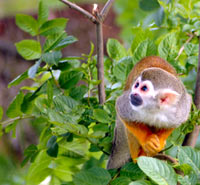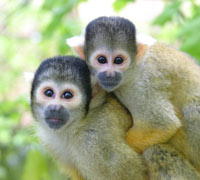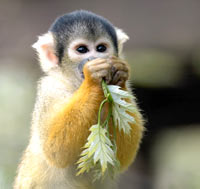|

Death head monkeys: Squirrel monkey fur is short and close, colored olive at the back and  yellowish orange on its belly and extremities. Their throat and the ears are white and their mouths are black. The upper part of their head is hairy. This black and white face gives them their German name, "death's head monkeys". yellowish orange on its belly and extremities. Their throat and the ears are white and their mouths are black. The upper part of their head is hairy. This black and white face gives them their German name, "death's head monkeys".
Small monkeys, big brains: Squirrel monkeys grow to 25 to 35 cm, plus a 35 to 42 cm tail. They weigh 750 to 1100g. Remarkably, the brain mass to body mass ratio for squirrel monkeys is 1:17, which gives them the largest brain, proportionately, of all the primates. Humans have a 1:35 ratio.

Speedy, daytime tree huggers: Like most of their New World monkey relatives, squirrel monkeys are diurnal and arboreal. Unlike the other New World monkeys, their tail is not used for climbing, but as a kind of "balancing pole" and also as a tool. Their movements in the branches are extremely speedy.
Huge groups of tiny monkeys: They live together in multi-male/multi-female groups with  up to 500 members. These large groups can, however, occasionally break into smaller troops. These areas they live are moist tropical forests, and they usually forage in the medium and lower levels of the forest and sleep close to the canopy. The females are the dominant members of the group. up to 500 members. These large groups can, however, occasionally break into smaller troops. These areas they live are moist tropical forests, and they usually forage in the medium and lower levels of the forest and sleep close to the canopy. The females are the dominant members of the group.
Traveling with other animals: It is common to see these squirrel monkeys in mixed groups, moving along with other primate species and birds.
Vocalizing danger: They have a number of vocal calls, including warning sounds to protect themselves from large falcons, which  are a natural threat to them. Their small body size also makes them susceptible to predators such as snakes and felids. For marking territory, squirrel monkeys rub their tail and their skin in with their own urine. are a natural threat to them. Their small body size also makes them susceptible to predators such as snakes and felids. For marking territory, squirrel monkeys rub their tail and their skin in with their own urine.
The fruit and insect diet: It is a very agile monkey, with a high metabolic rate, and an omnivorous animal, feeding on fruits, insects, and some leaves, seeds and other plant parts. Occasionally they also eat nuts, buds, eggs
and small vertebrates.
 The mating of the squirrel monkeys is subject to seasonal influences.
Females give birth to young during the rainy season, after a 150- to
170-day gestation. The mothers exclusively care for the young. Saimiri oerstedti are weaned by 4 months of age, while S. boliviensis are not fully weaned until 18 months old. Female squirrel monkeys reach sexual maturity at age 3 years, while males take until age 5. They live to about 15 years old in the wild, about 20 years in captivity. The mating of the squirrel monkeys is subject to seasonal influences.
Females give birth to young during the rainy season, after a 150- to
170-day gestation. The mothers exclusively care for the young. Saimiri oerstedti are weaned by 4 months of age, while S. boliviensis are not fully weaned until 18 months old. Female squirrel monkeys reach sexual maturity at age 3 years, while males take until age 5. They live to about 15 years old in the wild, about 20 years in captivity.

The Common Squirrel Monkey (Saimiri sciureus) is a small New World primate from the Cebidae family, and native to ten different countries of South America: Brazil, Colombia, Ecuador, French Guiana, Guyana, Peru, Suriname, Venezuela and Puerto Rico.
- Genus Saimiri
- S. sciureus group
- Central American Squirrel Monkey, Saimiri oerstedii
- Black-crowned Central American Squirrel Monkey, Saimiri oerstedii oerstedii
- Grey-crowned Central American Squirrel Monkey, Saimiri oerstedii citrinellus
- Common Squirrel Monkey, Saimiri sciureus
- Saimiri sciureus sciureus
- Saimiri sciureus albigena
- Humboldt's Squirrel Monkey, Saimiri sciureus cassiquiarensis
- Ecuadorian Squirrel Monkey, Saimiri sciureus macrodon
- Bare-eared Squirrel Monkey, Saimiri ustus
- S. boliviensis group
- Black-capped Squirrel Monkey, Saimiri boliviensis
- Bolivian Squirrel Monkey, Saimiri boliviensis boliviensis
- Peruvian Squirrel Monkey, Saimiri boliviensis peruviensis
- Black Squirrel Monkey, Saimiri vanzolini
Baboon | Howler Monkey | Lion Tamarin | Mandrill | Marmoset | Patas Monkey
Primates| Apes| Monkeys| Prosimians
All text is available under the terms
of the GNU Free Documentation License
|